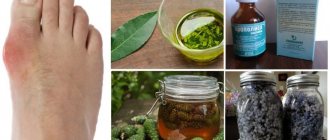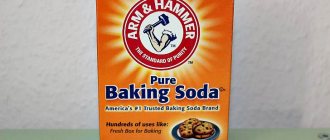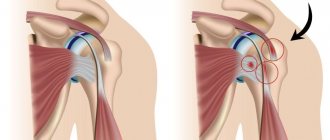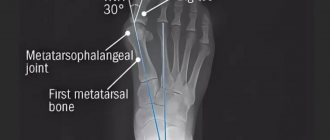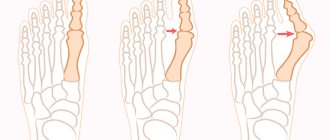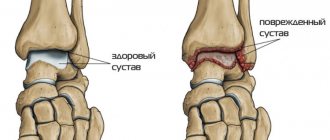Tenosynovitis (tendovaginitis; tendo- tendon + vagina vagina, synonym tenosynovitis) - inflammation of the synovial sheaths of the tendon.
The terms “ tenosynovitis ”, “tendevit”, “tenosynovitis”, “ligamentitis” are often used as synonyms, since all closely adjacent tissues are often affected - the tendon, its synovial sheath and the ligamentous canal. Tenosynovitis manifests itself as pain during active movement of any muscle or group of muscles, swelling along the tendon sheath, and crunching when moving. Most often, tenosynovitis affects the extensor tendon sheaths of the forearm, fingers, hand, leg, foot and Achilles tendon.
Which joints are most often affected?
A tendon connects bones or bones and muscles. It is covered on top with connective tissue, and on the inside with a synovial membrane that secretes lubricant for better gliding and movement of the limbs. The inflammatory process leads to disruption of this process. Sliding slows down and pain occurs.
Most often, inflammation affects the tendons of the forearm, hand, wrist, ankle and foot. Tenosynovitis can be acute or chronic. If, when the first signs of the disease appear, a person does not carry out effective treatment, does not fight inflammation and pain, and after the clinical manifestations subside, he continues to load the tendon, then the disease begins to recur frequently. Dystrophy of the tendon sheaths occurs, and motor activity drops sharply.
Up to contents
Characteristic features of the pathology
Tenosynovitis of the fingers, together with tendinitis, fasciitis, and bursitis, is included in a large group of pathologies - enthesopathies. This is the name for inflammation of the periarticular tissues, which occurs as periarthritis. First, one structure is damaged, and then nearby ligaments, tendons, and fascial sheets are involved in the destructive process. Gradually they lose strength, resilience, and elasticity, which leads to a significant decrease in their functional activity.
Along with tenosynovitis of the fingers, enthesopathy of the knee joint is most often diagnosed. These structures are susceptible to trauma and microtrauma - the main causes of disease development. The risk group includes athletes and people in their line of work who perform frequent monotonous movements.
What triggers the development of tenosynovitis?
Experts include the following provoking factors:
- microtrauma of tendons;
- heavy physical work associated with joint overload;
- bruises from an accidental fall on a sharply bent or straightened limb;
- spread of infection to the tendons and their sheaths with osteomyelitis, infectious arthritis, phlegmon;
- toxic reactive inflammation of tendons with rheumatic joint damage;
- entry of pathogens into joint structures through the bloodstream during tuberculosis, gonorrhea or other infectious diseases.
Up to contents
Kinds
Tenosynovitis of the fingers can be infectious and aseptic. The latter occurs as a result of damage to the inner lining of the tendon sheath and is not associated with the introduction of bacteria or viruses. Infectious diseases are classified depending on the species of microorganisms. The cause of the development of nonspecific tendovaginitis is the introduction of Staphylococcus aureus and epidermal Staphylococcus, Streptococcus, and Escherichia coli. Specific pathology is provoked by pathogens of gonorrhea, brucellosis, tuberculosis, and syphilis. In orthopedics, it is also customary to subdivide tenosynovitis as follows:
- professional aseptic. Its development is preceded by overload and microtrauma of the tendon sheath with monotonous frequent movements. The resulting inflammatory process can lead to destructive and degenerative changes in connective tissue structures;
- reactive aseptic. Occurs as a result of the immune system's response to the introduction of foreign proteins. Most often diagnosed in patients with local circulatory disorders, rheumatic pathologies
Tendinitis of the fingers can manifest itself acutely, with pronounced clinical manifestations. A chronic disease is characterized by alternating remissions with relapses that occur after hypothermia or excessive physical exertion.
How does tenosynovitis manifest?
Acute tendovaginitis develops as a result of sprains, bruises, and overload of the joints. The affected area swells greatly, pain appears along the tendon and in the rest of the limb, and a slight crunching sound is possible when moving. Painful sensations persist for 1–2 weeks and require high-quality pain relief.
With chronic tendovaginitis, pain occurs periodically and intensifies after physical activity. Over time, the sensitivity of the fingers decreases, and the limb loses muscle strength. This is especially noticeable with damage to the tendons of the wrist joint, in which the sick person loses the ability to make fine and precise movements with his hands.
Up to contents
Causes
In addition to injuries (dislocations, subluxations, ligament ruptures), inflammatory and degenerative pathologies can provoke the development of tenosynovitis of the fingers. These are gout, rheumatoid, reactive, psoriatic arthritis, deforming osteoarthritis. Also, the following conditions become prerequisites for damage to tendon sheaths:
- metabolic disorder;
- dysfunction of the endocrine glands;
- excessive physical activity;
- sedentary lifestyle;
- disorders of hematopoiesis and circulation.
One of the common causes of the development of tenosynovitis of the fingers is the penetration of pathogenic microorganisms into the periarticular structures. As a result of the active growth and reproduction of bacteria, toxic products of their vital activity are released into the surrounding space. In such cases, tenosynovitis is clinically manifested not only by pain in the joints, but also by symptoms of general intoxication.
Motrin® for tenosynovitis
Motrin® is a modern non-steroidal anti-inflammatory drug that helps relieve pain and inflammation, including tenosynovitis. Motrin® is clinically proven to provide pain relief for up to 12 hours1. At the same time, the active substance of the drug (naproxen) helps to cope with inflammation, reducing the activity of cyclooxygenase and blocking the synthesis of prostaglandins, which is important in the treatment of diseases such as tenosynovitis.
Before use, read the instructions.
Up to contents
Symptoms
The variety of types of tenosynovitis determines the number of symptoms manifested, as well as their severity. With aseptic pathology, a pulling, pressing pain occurs, intensifying with flexion and (or) extension of the fingers. Swelling is observed in the affected area, and the range of motion is significantly reduced. The skin turns slightly red and becomes hot to the touch. If a person does not seek medical help, the disease becomes chronic. One of its characteristic symptoms is a crunching sound when bending the joints. Upon palpation, mild discomfort occurs.
The clinical picture is somewhat different in patients with stenosing tenosynovitis. In the area of the fingers, the skin swells and seems to smooth out. The tissue thickens locally and a click is heard when flexed. In severe cases, the cause of stiffness is not the prevention of pain and the formation of inflammatory edema, but the formation of contractures.
Prevention
Aseptic tenosynovitis of the wrist joint is not difficult to prevent. To do this you need to follow simple rules:
- avoid excessive stress on joints;
- when performing long and monotonous work, take frequent breaks, stretching your hands;
- protect your hands from hypothermia;
- sitting at a computer or standing at a machine, you need to monitor the comfortable position of your limbs;
- if necessary, place a special cushion or pad under the wrist joint.
Infectious tendovaginitis is prevented by careful treatment of wounds and timely treatment of provoking diseases.
Since stress on the hands occurs not only at work, but also at home (this is especially true for women), it is necessary to make it a rule to take relaxing baths every night, followed by a massage and application of a medicinal cream. This will not only protect your hands from tendovaginitis, but also make them well-groomed and beautiful.
Perhaps, in order to maintain the health of your hands, you should think about changing your profession or significantly reducing the load on the tendons, while not forgetting about maintaining immunity, performing special gymnastics and leading a healthy lifestyle.
Tenosynovitis of the hands is not a disease that can be ignored. The pathology must be treated, and this must be done in strict accordance with the doctor’s prescriptions. The consequences of inflammation can be either minor or quite tragic - the disease threatens a lot of serious complications.
Author: Elena Medvedeva, doctor, especially for Ortopediya.pro
Aseptic (crepitating) form of the disease
The development of this form of the disease is caused by a lack of synovial fluid, which causes increased friction between the layers of the tendon sheath. An accumulation of serous or hemorrhagic exudate occurs in the capsule cavity. With proper and timely treatment, the exudate is converted into fibrinous, which indicates the beginning of regeneration.
However, clinicians have proven that in most cases, first-time aseptic tenosynovitis, treated incorrectly or insufficiently, develops into a chronic form. This can be explained by the formation of a large number of adhesions inside the capsule and the replacement of cells that form the synovial fluid with connective tissue.
Classification
When choosing a treatment method, doctors take into account the form of diagnosed tenosynovitis of the forearm. The most severe is a purulent pathology that develops as a result of tissue infection. It is characterized by the accumulation of purulent exudate in the tendon vagina, provoking a rapid worsening of symptoms and the spread of the inflammatory process to healthy areas. Serous tenosynovitis of the forearm is also isolated, in which the inner layer of the membrane is affected and a transparent protein-serous serum is released. Less common is a serous-fibrous disease, which occurs against the background of the formation of a specific plaque and the accumulation of serous exudate. The treatment methods used also depend on the form of the pathology:
- initial. There is hyperemia (overflow of blood vessels) of the synovial vagina, accumulation of perivascular infiltrate, usually localized in the outer membrane;
- exudative-serous. A small amount of effusion is detected in the tendon sheath, and the clinical picture is complemented by the formation of a small round swelling in the inflamed part of the tendon;
- stenosing. Sclerotic changes occur: the structures of individual layers are smoothed, the canal of the synovial vagina is partially or completely narrowed.
Tenosynovitis of the forearm can be aseptic or infectious, chronic or acute. There are primary diseases that develop after tendon injury. Secondary tendovaginitis occurs due to pathology already present in the body: arthritis, arthrosis, venereal, respiratory, intestinal infections.
The main cause of tendovaginitis is microtrauma.
Diagnostics
The most informative method of differential diagnosis is radiography. It allows you to exclude osteomyelitis, arthrosis, and all types of arthritis. The study is carried out to identify the localization of inflammation, its stage and course. CT or MRI are prescribed to patients to obtain images with clear visualization of the tendon, its sheath, ligamentous-muscular apparatus, and blood vessels. The images clearly show the developed complications of the inflammatory-degenerative pathology.
If an infectious nature of finger tendonitis is suspected, biochemical and serological studies and bacterial cultures are carried out. They help not only to establish the type of microorganism, but also its sensitivity to antibiotics.
Treatment
To eliminate pain, non-steroidal anti-inflammatory drugs are included in therapeutic regimens. These can be injection solutions (Ketorolac, Meloxicam), tablets (Nimesulide, Ibuprofen, Diclofenac), ointments for local application (Voltaren, Nise, Nurofen). After relief of inflammation, therapy continues with external medications with a warming and distracting effect: Capsicam, Finalgon, Apizatron, Nayatox. Glucocorticosteroids are used extremely rarely - usually when performing electrophoresis in combination with anesthetics. Patients are recommended to take a long-term course of chondroprotectors:
- Artra;
- Teraflex;
- Structum.
The drugs not only stimulate the restoration of damaged joint structures, but as they accumulate in the body they exhibit a pronounced analgesic and anti-inflammatory effect. Patients are also advised to wear elastic bandages that secure the hand without restricting movement. In case of acute inflammation, a plaster cast will be applied.
Shock wave therapy treatment
Shock wave therapy (SWT) remains the leading physiotherapy treatment for digital tenosynovitis. Due to the difference between the acoustic resistance of the soft and dense structures of the hand, the waves emitted by the device penetrate into the deepest damaged tissues. Already after the first session, the severity of pain decreases, swelling and redness of the skin is eliminated. UVT is used to accelerate the restoration of mobility of the wrist joint, flexors and extensors of the hand. It is worth noting a certain regenerating ability of physiotherapeutic manipulation.
Tenosynovitis of the fingers responds well to treatment if you consult a doctor in a timely manner. Therefore, you should make an appointment with an orthopedist or traumatologist when the first, mild discomfort appears.
Clinical manifestations of various forms of the disease
The symptoms of acute and exacerbations of chronic tendovaginitis include the following clinical manifestations:
Pain in this disease is felt clearly in the projection of the location of the affected tendon. the pain is acute and constant and intensifies when trying to move. In the case of purulent inflammation, there is a feeling of pulsation.
Nonseptic tenosynovitis is characterized by the presence of crepitus (crunching) about the joint area. Swelling, the development of which is due to the dilation of blood vessels and an increase in the permeability of their walls. A distinctive feature of edema with tendovaginitis is its rapid development and spread.
Hyperemia (redness) and hyperthermia (local increase in temperature) are also caused by a sharp dilation of blood vessels, provoked by the inflammatory process. Impaired functioning of the affected limb. After the acute period of the disease has passed, contractures often develop in the area of the diseased tendon. They provoke a decrease in the length and curvature of the synovial sheath, which leads to limited mobility of the tendon.



